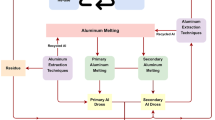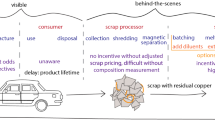Abstract
About one-third of a grinding wheel is required for clamping. This portion remains unusable after the grinding wheel is consumed. However, this portion has virgin abrasives which can be used for grinding. The challenge is to recover the grains from the spent wheel, segregate the grain from the bond and to take stock of the property changes that might have happened during vitrification. If these can be done effectively, then the grain, initially declared as waste, can be used for re-manufacturing of grinding wheels. This paper describes methods to regenerate the grains from spent vitrified grinding wheels and indicates how the property can be characterized for reusability of the recovered grits. Chemical separation method was employed to remove the bond from the grinding wheel. A modified ball milling method is proposed to overcome the normal issue of agglomerates faced in recovered grits. Scanning electron microscope images of standard and recovered grains show the presence of sharp edges. So, these recovered grains could be reused for making grinding wheels. Results indicate that the so-called waste grains are tougher and can be used as value-added material in resinoid and coated abrasives.











Similar content being viewed by others
References
Terazono A, Murakami S, Abe N, Inanc B, Moriguchi Y, Sakai SI, Wong MH (2006) Current status and research on E-waste issues in Asia. J Mater Cycles Waste Manag 8(1):1–12
Abdelkader A, Osman AI, Halawy SA, Mohamed MA (2018) Preparation and characterization of mesoporous γ-Al 2 O 3 recovered from aluminium cans waste and its use in the dehydration of methanol to dimethyl ether. J Mater Cycles Waste Manag. 1–9
Lee WH, Hsu CW, Ding YC, Cheng TW (2018) A study on recovery of SiC from silicon wafer cutting slurry. J Mater Cycles Waste Manag 20(1):375–385
Liu L, Liang Y, Song Q, Li J (2017) A review of waste prevention through 3R under the concept of circular economy in China. J Mater Cycles Waste Manag 19(4):1314–1323
Doi T, Uhlmann E, Marinescu ID (eds) (2015) Handbook of ceramics grinding and polishing. William Andrew
Berkun M, Aras E, Anılan T (2011) Solid waste management practices in Turkey. J Mater Cycles Waste Manag 13(4):305–313
Biao ZH, Tianyu YU, Wenfeng DI, Xianying LI (2017) Effects of pore structure and distribution on strength of porous Cu-Sn-Ti alumina composites. Chin J Aeronaut 30(6):2004–2015
Ding W, Dai C, Yu T, Xu J, Fu Y (2017) Grinding performance of textured monolayer CBN wheels: undeformed chip thickness nonuniformity modeling and ground surface topography prediction. Int J Mach Tools Manuf 122:66–80
Liu C, Ding W, Yu T, Yang C (2018) Materials removal mechanism in high-speed grinding of particulate reinforced titanium matrix composites. Prec Eng 51:68–77
Dai C, Ding W, Xu J, Fu Y, Yu T (2017) Influence of grain wear on material removal behavior during grinding nickel-based superalloy with a single diamond grain. Int J Mach Tools Manuf 113:49–58
Xi X, Ding W, Fu Y, Xu J (2018) Grindability evaluation and tool wear during grinding of Ti2AlNb intermetallics. Int J Adv Manuf Technol 94(1–4):1441–1450
Ding W, Zhang L, Li Z, Zhu Y, Su H, Xu J (2017) Review on grinding-induced residual stresses in metallic materials. Int J Adv Manuf Technol 88(9–12):2939–2968
Andreola F, Barbieri L, Lancellotti I, Bignozzi MC, Sandrolini F (2010) New blended cement from polishing and glazing ceramic sludge. Int J Appl Ceram Tec 7(4):546–555
Babu MK, Chetty OK (2003) A study on recycling of abrasives in abrasive water jet machining. Wear 254(7):763–773
Akcil A, Vegliò F, Ferella F, Okudan MD, Tuncuk A (2015) A review of metal recovery from spent petroleum catalysts and ash. Waste Manage 45:420–433
Sun ZH, Xiao Y, Sietsma J, Agterhuis H, Yang Y (2016) Complex electronic waste treatment–An effective process to selectively recover copper with solutions containing different ammonium salts. Waste Manage 57:140–148
Bernal SA, Rodríguez ED, Kirchheim AP, Provis JL (2016) Management and valorisation of wastes through use in producing alkali-activated cement materials. J Chem Technol Biotechnol 91(9):2365–2388
Trischuk RW, Garg AK, Khaund AK (1996) U.S. Patent No. 5,578,222. U.S. Patent and Trademark Office, Washington, DC
Tuncuk A, Ciftlik S, Akcil A (2013) Factorial experiments for iron removal from kaolin by using single and two-step leaching with sulfuric acid. Hydrometallurgy 134:80–86
Chandrasekhar S, Ramaswamy S (2006) Iron minerals and their influence on the optical properties of two Indian kaolins. Appl Clay Sci 33(3):269–277
Dermont G, Bergeron M, Mercier G, Richer-Lafleche M (2008) Soil washing for metal removal: a review of physical/chemical technologies and field applications. J Hazard Mater 152(1):1–31
Borra CR, Pontikes Y, Binnemans K, Van Gerven T (2015) Leaching of rare earths from bauxite residue (red mud). Miner Eng 76:20–27
Li N, Zeng FB, Li J, Zhang Q, Feng Y, Liu P (2016) Kinetic mechanics of the reactions between HCl/HF acid mixtures and sandstone minerals. J Nat Gas Sci Eng 34:792–802
Rosales GD, del Carmen Ruiz M, Rodriguez MH (2014) Novel process for the extraction of lithium from β-spodumene by leaching with HF. Hydrometallurgy 147:1–6
Nadolny K (2014) State of the art in production, properties and applications of the microcrystalline sintered corundum abrasive grains. Int J Adv Manuf Technol 74(9–12):1445–1457
Acknowledgements
This project was funded by the Department of Science and Technology, Government of India, under the Technology Systems Development Programme (TSDP) for Waste management [Grant number DST/TSG/WM/2015/567/G].
Author information
Authors and Affiliations
Corresponding author
Rights and permissions
About this article
Cite this article
Sabarinathan, P., Annamalai, V.E., Kumar, S.S. et al. A study on recovery of alumina grains from spent vitrified grinding wheel. J Mater Cycles Waste Manag 21, 156–165 (2019). https://doi.org/10.1007/s10163-018-0776-8
Received:
Accepted:
Published:
Issue Date:
DOI: https://doi.org/10.1007/s10163-018-0776-8




